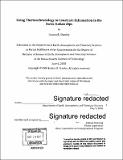| dc.contributor.advisor | Samuel Bowring. | en_US |
| dc.contributor.author | Stanley, Jessica R | en_US |
| dc.contributor.other | Massachusetts Institute of Technology. Department of Earth, Atmospheric, and Planetary Sciences. | en_US |
| dc.coverage.spatial | ea----- | en_US |
| dc.date.accessioned | 2018-03-27T14:19:12Z | |
| dc.date.available | 2018-03-27T14:19:12Z | |
| dc.date.copyright | 2008 | en_US |
| dc.date.issued | 2008 | en_US |
| dc.identifier.uri | http://hdl.handle.net/1721.1/114362 | |
| dc.description | Thesis: S.B., Massachusetts Institute of Technology, Department of Earth, Atmospheric, and Planetary Sciences, 2008. | en_US |
| dc.description | Cataloged from PDF version of thesis. | en_US |
| dc.description | Includes bibliographical references (pages 52-56). | en_US |
| dc.description.abstract | Twelve bedrock samples were collected from Ticino, Switzerland and Northern Italy for thermochronological studies using the (U-Th)/He technique on zircon and apatite and fission track on subset of zircons. Nine samples were collected from the Lepontine Dome, north of the Insubric Line, six of which were in an approximate vertical, or elevation, transect. Three samples were also taken in a vertical transect from the Southern Alps, south of the Insubric Line. (U-Th)/He Zircon dates from north of the Insubric line ranged from 7 to 14 Ma, and indicate an approximate exhumation rate for the region of 1000 m/Ma. U-Th/He zircon dates from south of the Insubric Line ranged from 100 to 180 Ma, with one reliable apatite date of 23 Ma. These data lead to an approximate exhumation rate of 20 m/Ma in the south with rates increasing to about 150 m/Ma since 23 Ma. Thus very different exhumation histories can be inferred north and south of the Insubric Line, with the north side showing much younger dates and a higher exhumation rate related to continued orogenic activity, whereas to the south, there are lower rates and older dates indicating little to no orogenic activity until ca 23 Ma. | en_US |
| dc.description.statementofresponsibility | by Jessica R. Stanley. | en_US |
| dc.format.extent | 66 pages | en_US |
| dc.language.iso | eng | en_US |
| dc.publisher | Massachusetts Institute of Technology | en_US |
| dc.rights | MIT theses are protected by copyright. They may be viewed, downloaded, or printed from this source but further reproduction or distribution in any format is prohibited without written permission. | en_US |
| dc.rights.uri | http://dspace.mit.edu/handle/1721.1/7582 | en_US |
| dc.subject | Earth, Atmospheric, and Planetary Sciences. | en_US |
| dc.title | Using thermochronology to constrain exhumation in the Swiss-Italian Alps | en_US |
| dc.type | Thesis | en_US |
| dc.description.degree | S.B. | en_US |
| dc.contributor.department | Massachusetts Institute of Technology. Department of Earth, Atmospheric, and Planetary Sciences | |
| dc.identifier.oclc | 1028981099 | en_US |
